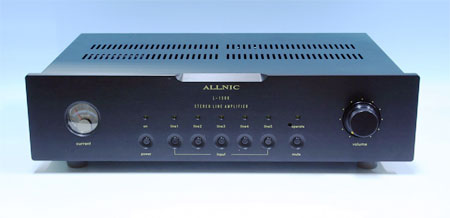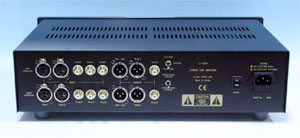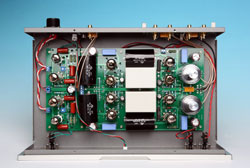| ALLNIC L-1500 preamp - High, Wide and Deep sound
stage |
 My Associate Editor
David McCallum turned me on to this import from South Korea,
distributed in North America by Hammertone Audio. David Beetles,
Hammertone Audio’s
owner, was kind enough to have us audition the unit to qualify
for an evaluation. Well, it did, and furthermore, I feel
that it is an important component with which to step into
the world of high performance audio. Allnic Audio has been
in business since 2005, although its principal Kang Su Park
has been around serious audio for a long time — long
enough, in fact, that he has become a well-known audiophile
personality in his country as well as in other markets such
as Japan and the UK. He designs and tests all parts and components
with the help of his employees — all members of his
family — to assure the tightest quality control. It
seems that KSP is a perfectionist who goes to great length
to find the best parts and doesn’t hesitate to manufactures
his own should he not find what he is looking for. All of
his designs employ premium parts, but his forte, it seems,
is the method he employs for vacuum tube voltage regulation
to achieve a very low noise floor of low-level circuits,
particularly in power transformers and rectifying circuits.
In addition, Kang Su Park insists on the proper tube type
selection for the intended application and carefully matched
circuits to his transformers which use Permalloy-core signal-path
technology, said to be almost free of noise. Allnic manufactures
power amps, preamps and — its
specialty — phono preamplifiers. My Associate Editor
David McCallum turned me on to this import from South Korea,
distributed in North America by Hammertone Audio. David Beetles,
Hammertone Audio’s
owner, was kind enough to have us audition the unit to qualify
for an evaluation. Well, it did, and furthermore, I feel
that it is an important component with which to step into
the world of high performance audio. Allnic Audio has been
in business since 2005, although its principal Kang Su Park
has been around serious audio for a long time — long
enough, in fact, that he has become a well-known audiophile
personality in his country as well as in other markets such
as Japan and the UK. He designs and tests all parts and components
with the help of his employees — all members of his
family — to assure the tightest quality control. It
seems that KSP is a perfectionist who goes to great length
to find the best parts and doesn’t hesitate to manufactures
his own should he not find what he is looking for. All of
his designs employ premium parts, but his forte, it seems,
is the method he employs for vacuum tube voltage regulation
to achieve a very low noise floor of low-level circuits,
particularly in power transformers and rectifying circuits.
In addition, Kang Su Park insists on the proper tube type
selection for the intended application and carefully matched
circuits to his transformers which use Permalloy-core signal-path
technology, said to be almost free of noise. Allnic manufactures
power amps, preamps and — its
specialty — phono preamplifiers.
Appearance
Well, this preamplifier isn’t a very modern-looking
component and its dimensions are standard and plain with
a black enclosure and faceplate. It measures 430mm wide,
300mm deep, 120mm high (17” x 11.8” x 48”)
and weighs in at 9kg (19.85 pounds). However, the L-1500
distinguishes itself with a touch of the retro look that
includes a small VU meter on the unit’s left side of
the faceplate and alludes to the tube-based technology of
the design. Five small push buttons and indicator lights
across the front are the input selection switches for three
unbalanced (single-ended) and two balanced inputs. The volume
knob is on the unit’s right and finishes the rather
uncomplicated, logical layout of the component. It can be
connected in balanced or unbalanced configuration via its
two outputs located, of course, on the rear of the unit.
 The Sound The Sound
The two power amplifiers I used for this evaluation were
the powerful Bryston 7B SST Squared monoblocks and the
Genesis power amplifier — both synergistic complements
with my auditioning speakers, the earlier reviewed Genesis
5.3 and my own Ethera Vitae loudspeakers. Source components
included an Esoteric DAC and an Elite transport. The speaker
cables and interconnects on hand were the new XLO’s
Purple Reign as well as the much lower-priced Argentum
cables and Genesis’ own custom speaker cables.
As with any new component in a system, I wanted to acquaint
myself with the Allnic’s sonic personality and operated
the preamplifier connected to the familiar power amplifiers
for a few weeks. When I was sure that the unit had settled
well into its new electronic environment, I began to pay
attention to all the important particulars. Thus, I listen
for the preamplifier’s crucial constituents such as
clarity, resolution, frequency reach, detail, sound stage
and — the most important — its musicality.
The thing I noticed first was how the Allnic presented a
rather lush-sounding though harmonious flow across the entire
audible frequency range. Connected to the Brystons, the preamplifier’s
all-round musical personality is very pleasing with an involving,
subtle effect or contrast, rather than sharp definition.
The sound can be likened the soft glow of a lamp, rather
than a glare of headlights. In other words, its voice is
quiet and gentle. This disposition adds a beautiful glow
to the upper midrange and high frequency section without
excessively diminishing resolution where and when called
for by instruments such as horns, woodwinds etc. Deep bass,
such as found on well-recorded CDs featuring the pedal notes
of an organ (Dorian’s The great Organ On St Eustache
is a great example) sounds realistic and mellifluously, though
falls just short of the best achievable resolution. However,
the L-1500 still manages to charm listeners, because its
musical caliber, in essence, prevents this small imperfection
from being known or noticed.
 The Allnic presents an amazingly high, wide and deep sound
stage and enables the listener to see (or hear) into it.
Almost all visitors I had over while I conducted some of
my listening tests mentioned that the loudspeakers literally “disappeared”.
There were a couple of issues, nevertheless; the L-1500 slightly
diminishes the absolute focus on instruments and voices performing
around the upper midrange frequencies — in the region
between 1,200 Hz to 1,300 Hz. As the preamp holds steadfastly
onto frequencies above and below, (inner) detail retrieval
is not affected at all. Indeed, I hold that detail with even
large orchestral music is as realistic as can be found when
listening to live performances — nothing is reproduced
with excessive emphasis, just the way it should be. Although
I have used the term “inner detail” in the past,
I actually think that it isn’t correctly describing
what it is or what it is I am looking for. I now believe
that a component that allows us to hear inner detail is as
a rule a high-resolution design, but does not accentuate.
Rather, it recreates the sonic subtleties inside the range
of a complex musical program material — thus, I think “detail” is
closer in accordance with fact when one compares the performance
of a system or a component with a live concert (try to find
inner detail in a 55 piece orchestra). The Allnic presents an amazingly high, wide and deep sound
stage and enables the listener to see (or hear) into it.
Almost all visitors I had over while I conducted some of
my listening tests mentioned that the loudspeakers literally “disappeared”.
There were a couple of issues, nevertheless; the L-1500 slightly
diminishes the absolute focus on instruments and voices performing
around the upper midrange frequencies — in the region
between 1,200 Hz to 1,300 Hz. As the preamp holds steadfastly
onto frequencies above and below, (inner) detail retrieval
is not affected at all. Indeed, I hold that detail with even
large orchestral music is as realistic as can be found when
listening to live performances — nothing is reproduced
with excessive emphasis, just the way it should be. Although
I have used the term “inner detail” in the past,
I actually think that it isn’t correctly describing
what it is or what it is I am looking for. I now believe
that a component that allows us to hear inner detail is as
a rule a high-resolution design, but does not accentuate.
Rather, it recreates the sonic subtleties inside the range
of a complex musical program material — thus, I think “detail” is
closer in accordance with fact when one compares the performance
of a system or a component with a live concert (try to find
inner detail in a 55 piece orchestra).
Synopsis & Commentary
The Allnic L-1500 is the type of component that enables listeners
to recognize what us audio folks call musicality and, when
coupled with great-sounding amplifiers it becomes clear how
important a good preamplifier’s functions are. The
Allnic does — of course — pre-amplify a low-level
signal of a power amplifier to line level; but in addition
to this basic function it provides a noise-free switcher
for its source component inputs. Most importantly, it provides
enough sonic neutrality to hear and recognize instruments
and voices by processing and delivering the considerable
extent of harmonics in a musical signal. Like all components
in an audio system the L-1500 has a sonic signature uniquely
its own and, while it falls short of perfection, its “voice” strongly
resembles that of the very high-end preamplifiers I have
auditioned in the past few years. Its most important strength
is its musicality — the coordination of harmony rhythm
and timing — and the fair price for such an outstanding
instrument. When this preamp is paired with solid-state amplifiers,
it will take away some of the “bite” and make
the all-round sound a little smoother, although any good
vacuum tube amplifier will likely enhance the L-1500’s
noise-free performance. Though the budget version of its
high-end sibling, the L-3000, it doesn’t sound “budget” at
all, and I have no qualms to recommend it to all those who
refuse to pay over $10k for a preamplifier.
L-1500 is the budget version of L-3000 and, hopefully, I
will have a review of it when I get a hold of one from Hammertone
Audio. It is said to be one of the best in the business,
which is the reason I rated the L-1500 just short of perfect. |
| MODELS |
MANUFACTURER |
| Allnic L-1500 Line-Stage Preamplifier |
ALLNIC Audio Labs |
| RATING |
CONTACT |
♪♪♪♪
|
Hammertone Audio
www.hammertoneaudio.com
|
| PRICE |
$5,900.00 (US)
|
| Dimensions |
| |
|
 |
TECHNOLOGY
The unit has been designed with attention to signal purity
and employs a single gain stage circuit with only one tube
in its amplification. This method is said to reproduce cleaner,
more detailed sound and is, in fact, quite apparent when
listening to a high-resolution audio system. One of the unique
methods used here is output transformer coupling, instead
of capacitor coupling. Transformer coupling allows more real
energy (about 90% of wattage not merely voltage) to drive
the power amplifier. However, as the transformer’s
quality is of the utmost importance, Allnic designed its
own model and customized it to suit their choice of vacuum
tubes. The Allnic transformer has unprecedented wide wave
response (16Hz ~ 75kHz, -3db) with low distortion. The design
assures the unwavering low output impedance of 150 ohms at
all frequencies and to complement this the L-1500 used an
advanced, ultra high-speed automatic voltage regulation circuit.
This protects the amplifying tube(s) from any changes in
the AC line and manages sudden internal current demands.
There is a 40 second automatic muting circuit to prevent
harmful transients to power amplifier
and loud speakers,
while warming up the preamplifier. The front-mounted illuminated
analog current meter displays the preamp’s status;
any sort of malfunction or damage in parts will make the
indicator needle move off the point.
Allnic also employs
its patented "Absorb GEL tube damper" technology,
which prevents vibrations or microphonic noise to enter the
signal path (this is also quite apparent in listening tests).
Although the volume knob seems a bit on the sluggish side
when it is rotated, it is a really solid in-house design
that practically eliminates all noise and channel imbalance.
It utilizes a precision oil clutched, motorized, 41 step
silver contact attenuator for precise tracking. It can be
operated via a simple remote control. All in all, this preamplifier
design is technology based without, however, ignoring the
importance of component synergy and system coherency.
The L-1500’s input impedance is 10 10kΩ unbalanced,
20kΩ balanced; frequency range is from 20Hz to 20kHz
(FLAT), or from 16Hz to 75kHz (-3dB); voltage gain is +20dB;
THD (1kHz) with 0.3V output is 0.06% and 0.15% with 1.0V
output 1.0V; S/N ratio is -90dB (CCIR, 1kHz); maximum output
is 15V RMS (non clipping); output impedance is 150Ω constant.
Tube complement: D3a or equivalent × 2 7233 × 2,
6485 × 2 (Voltage Regulator) |
|
